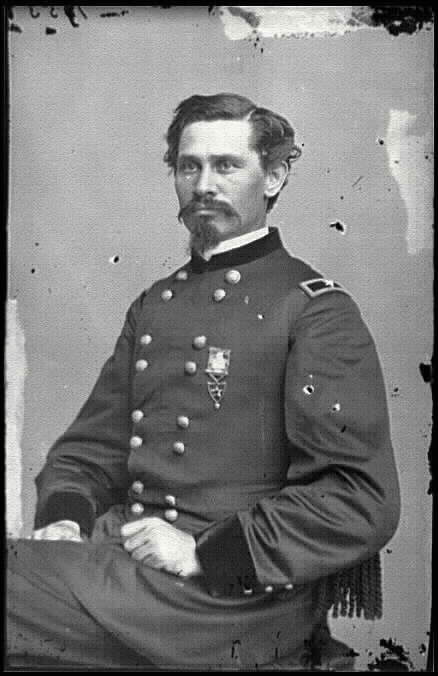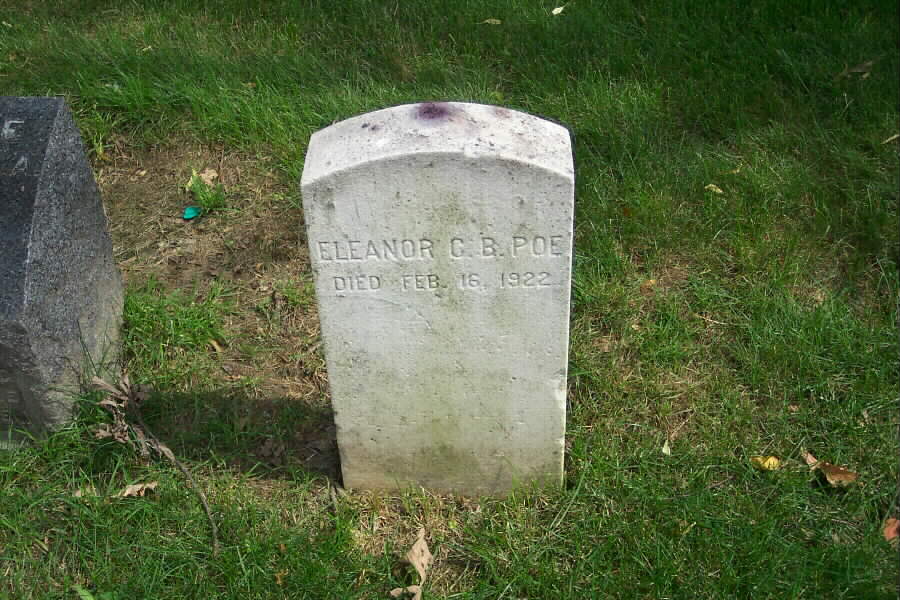Orlando Metcalfe Poe was born March 7, 1832, at Navarre, Ohio. He graduated from the United States Military Academy in 1856, 6th in his class, and was appointed to the Corps of Topographical Engineers (merged into Corps of Engineers in 1863).
During the interval before the Civil War, he was in the field on the survey of the northern lakes and promoted to First Lieutenant in 1860. The following year he became one of George B. McClellan’s principal subordinates, first in Ohio, and then subsequently in West Virginia and the Washington, D.C. defenses.
He was appointed Colonel of the 2nd Michigan Volunteer Infantry in September, and commanded his regiment during the initial stages of the Peninsular Campaign. He was absent on sick leave during Seven Days battles, but during the campaign of Second Manassas he was given the direction of a brigade of Kearny’s III Corps Division. After this Union debacle his troops were kept in Washington, D.C. until after battle of Sharpsburg, but in December at Fredericksburg he was again in the field, as the commander of a brigade of the IX Corps which was lightly engaged in the battle. In the meantime he was appointed a Brigadier General of Volunteers on November 1862, but his appointment was not confirmed by the Senate, and on March 4, 1863, he reverted to his Regular Army rank of Captain of engineers.
One of his biographers states that “the Senate failed to confirm his appointment”; however, we can find no evidence that he was appointed a Brigadier General in the Volunteer army more than once. He later served successively as Chief Engineer of XXIII Corps and the Army of the Ohio; in this position he was responsible for the defenses of Knoxsville which repelled Longstreet’s assaults in November April 1864.
William T. Sherman made him Chief Engineer of Military Division of the Mississippi, and he rendered distinguished service in the Atlanta Campaign, the “March to the Sea,” and the Carolinas Campaign.
He was breveted Brigadier General, United States Army, at the war’s end.
In 1873 became a staff Colonel and aide-de-camp to General Sherman, then General-in-Chief of the Army, a position which he occupied until Sherman’s retirement in 1884. Both before and after his association with Sherman, he had a distinguished peacetime career as a military engineer and was promoted through grades to Colonel of Engineers in 1888.
He served on Lighthouse Board, as supervisor of various projects in Great Lakes, and in protecting construction of the trans-continental railroads. While inspecting the Soo Locks in Michigan he suffered an injury which resulted in his death on October 2, 1895. He was buried in Section 1, Grave 143-A, of Arlington National Cemetery beneath a stone which reads, in part:
“Mark the perfect man and behold the upright for the end of that man in peace.”
His son, Charles Carroll Poe, Cadet, United States Navy, December 14, 1863-May 8 1895, and his wife, Eleanor C. B. Poe, who died on February 1922, are buried with him. In addition, we have learned that his youngest son, Orlando Warner Poe, who was born in Washington, D.C. in 1876 and who died in Detroit, Michigan, on 30 March 1889, is also buried in this site. He was originally buried at Detroit’s Elmwood Cemetery on April 5, 1889. However, the records indicate that his remains were then moved to Arlington on March 28, 1905.
GENERAL O. M. POE DEAD
Gallant Soldier and Famous Engineer Hurt on Official Duty at
Sault Ste. Marie and Died of Erysipelas
DETROIT, Michigan, October 2, 1895 – Brigadier General O. M. Poe, Colonel of Engineers, died at his residence here this morning agedsixty7-threeyears. The immediate cause of death was erysipelas.
General Poe had been confined to his home since his return from Sault Ste. Marie ten days ago where he had gone to inspect break which had occurred in the MITRE sill under the upper guard gates of the new American lock while they were being tested. While making the inspection, General Poe fell and received an injury which brought on the attack of the malady which killed him.
Orlando Poe was born in Ohio and appointed a Cadet to West Point from that State, graduating in 1856. He was assigned to the Engineer Corps and when the war broke out he held the rank of First Lieutenant. In September 1861 we were commissioned Colonel of the Second Michigan Volunteers November20, 1862. He was promoted to Captain in the Engineer Corps March8, 1863. During the war he was brevetted Major, Lieutenant Colonel and Brigadier General for meritorious service at Knoxville, Atlanta and Savannah, and in the campaign terminating with the surrender of General Johnston. On the 7th of March 1867 he was Major of Engineers, Lieutenant Colonel June 30, 1882, and Colonel July 28, 1888.
At the conclusion of the war Colonel Poe was assigned to duty as Engineer secretary of the Lighthouse Board. Which position he held until 1870. From 1870 to 1872he was Engineer of the Upper Lakes Lighthouse District.
Since 1872 he had served in the lakes region, always having important improvements under his supervision. These included works on Lakes Superior, Huron, Michigan and St. Mary’s Falls Canal, dam on the rapids of St. Mary’s River, and the survey of certain historic ground. He also served as a member of various boards on river and harbor improvements and bridge improvement.
If he had lived, he would have been placed on the retired list of the army next year on account of the age limit.
The death of General Poe will cause the promotions of the following members of the Engineer Corps: Lieutenant Colonel George L. Gillespie, on duty at New York; Major William A. Jones, St. Paul; Captain William H. Dixby, Columbus; Second Lieutenant Hiram M. Chittenden, Eureka, California; Additional Second Lieutenant Charles W. Kutz, Willett’s Point. Colonel Mendall, the senior officer of that rank, will be retired next month and addition promotions will follow.
There was a plan by the Lake Carriers’ Association and other vessel owners to have General Poe retained in active service until the new American Canal at the Soo and the twenty-foot channel project, through the chain of the great lakes, of which the General had supervision, and in which he was deeply interested, were completed.
The announcement of General Poe’s death was a great surprise to officers on duty at Washington. The only intimation that they had was that he was not well was contained in a letter from the deceased which reached here this morning.
Colonel Mackenzie of the Engineer Corps was reading this letter when informed of his death by a reporter of the United Press. The letter was dated September30 and read: “I have been confined to my bed, first from an injury received at the Sault Ste. Marie, and afterward by an attack of malarial fever. At present I am unable to get up, and cannot attend to any business except the routine work. Cannot prepare the report. Doctors cannot say how long the attack will last – in fact, they do not know.”
POE – At 138 West 81st Street, New York City, on May 18, 1895, Charles C. Poe, son of General O. M. Poe, U.S.A.
Re: Information needed – not sure what you are looking for in the way of information on General Fitzhugh but he and Colonel Robt Hughes Fitzhugh were brothers – the children of Henry Fitzhugh and Anna Barbara Carroll – Henry Fitzhugh’s father Colonel William Fitzhugh moved up to upper New York State about 1812 – from Maryland – but they are descendants of William Fitzhugh who settled in Virginia in the late 18th century and were cousins of Robert E. Lee.
General Charles L. Fitzhugh’s eldest son Henry’s first and third wives (Winnifred and Elizabeth) were daughters of General Orlando Poe also buried in Arlington – I think that Winnifred Poe Fitzhugh is buried in the Poe plot. George K Fitzhugh buried in the Fitzhugh plot was the second son and the youngest was Carroll Hamilton Fitzhugh.
General Charles L. Fitzhugh married Emma Shoenberger the daughter of George K. Shoenberger – of Cincinnati – an heiress whose family were prominent in the Iron and Steel industry – They lived in Pittsburgh where eventually Fitzhugh became president of the Shoenberger Steel Company. About 1904 the Fitzhughs moved to Washington D.C. where they built a house on Sheridan Circle.
Hope this is of interest.
Cheers Rob Mikel, Toronto, Canada
May 25, 1895 Page 1
Death of Chas. C. Poe
Charles Carroll Poe. Son of Col. O. M. Poe, of Detroit, died suddenly in New York early last Saturday morning. The deceased was well known in the Soo. He held a position here in 1885 under the government as an inspector of dredge work, and was united in the city on numerous occasions since that time. He was the possessor of marked ability and was held in the highest esteem by those who knew him. He was 31 years of age.
October 04, 2007
Colonel Poe was a master of destruction
By Roy Parker
Courtesy of the Fayetville (North Carolina) Observer
Colonel Orlando Metcalfe Poe is the man. A quintessential Midwesterner, he was the innovative engineer who, in the closing days of the Civil War, superintended the razing of the military facility which during the war was the Fayetteville Arsenal and Armory of the Confederate States of America.
Poe was chief engineer in the army of General William Tecumseh Sherman as it blazed its way across the heartland of the dying Confederacy, from Atlanta, to Savannah, to Columbia and on into North Carolina.
By the time he got to Fayetteville on March 11, 1865, Orlando Poe was a master of destruction. He was an old hand at smashing arsenals.
Sherman described what would happen. In a letter written from his headquarters on the grounds of the ordnance facility that once again flew the Stars and Stripes, he informed his boss, Gen. U.S. Grant, that the “magnificent United States Arsenal” would be destroyed because he didn’t have enough troops to leave a guard for it: “I therefore shall burn it, blow it up with gunpowder, and then with rams knock down the walls.”
A young Fayetteville girl who lived nearby described the scene in a memoir written years later: “The nights were made hideous with smoke. The crowning point of this nightmare of destruction was the burning and battering down of our beautiful and grandly magnificent Arsenal which was our pride and the show place of our town.”
Poe’s terrible handiwork as commander of what the enemy called “Sherman’s fire fiends” began in the summer of 1864 in Atlanta.
In his memoirs, Sherman described “Poe’s special task of destruction.”
Sherman wrote: “He had a large force at work that leveled the great depot, round-house and the machine-shops of the Georgia Railroad and applied fire to the wreck.”
A shop being used as an arsenal burned, shells exploded, and wrote Sherman, “the night was made hideous by the bursting of the shells.”
As the bluecoat army moved out on its march through Georgia, Poe’s engineers, mostly men of the 1st Michigan Regiment of Engineers and Mechanics, systematically destroyed railroads with a method devised by Poe.
Sherman wrote: “The whole horizon was lurid with the bonfires of rail-ties, and groups of men all night were carrying the heated rails and bending them around tree trunks.”
When they arrived in Columbia, South Carolina, in February of 1865, “troops under the immediate command of Colonel Poe destroyed the state arsenal, which was found to be well supplied with shot, shell and ammunition. They were hauled in wagons to the Saluda River and emptied into deep water.”
For once, however, the destructors tasted their own medicine when an accidental explosion of powder killed 16 soldiers of the engineer regiment.
Poe was a native Ohioan who spent most of his life near the shores of the Great Lakes.
Born in 1832, he graduated from West Point in 1856, ranking sixth in his class and admired as a talented draftsman of the elite corps of topographical engineers, the mapmakers of the Army.
In the years before the Civil War, he surveyed the coastlines of the Great Lakes, devising elegant maps of sites for public works projects.
In the first years of the war, he briefly commanded a Michigan volunteer regiment but was soon tapped for staff engineer posts, first with General George B. McClellan, and then under Sherman.
He was responsible for defenses of Knoxville, Tennessee, when a Confederate army besieged the town in 1863. He also supervised engineering work on the extensive defenses ringing Washington.
When his appointment as a Brigadier General of volunteers was bypassed by the U.S. Senate, he reverted to his Regular Army rank of Captain.
Sherman eagerly hired him and made him engineering chief of his army.
He was breveted Brigadier General, United States Army, at the war’s end.
Even as the guns fell silent, Poe returned to his prewar love, the public works of the Upper Great Lakes.
He was on the Lighthouse Board supervising navigational projects on Lakes Huron and Michigan.
From 1873 until 1884, he also ranked as engineering chief on the staff of Sherman, by then the general in chief of the U.S. Army.
In that capacity, he advised on engineering and security for four transcontinental railroad lines.
And so in peacetime, the man who wrought such destruction in war was able to indulge his passion and his talent for building and designing by overseeing construction of rugged lighthouses that still dot the shorelines of the Great Lakes.
A history of the era descried Poe’s contribution in one instance: “Poe’s design for the Outer Island Light was unique, in that it was designed not only to be thoroughly appropriate for the need, but also included design elements normally reserved for major public buildings and stately homes.
“The gracefully tapering 80-foot light tower’’ was attached to a three-story keeper’s dwelling “with a gable roof and with partial hips at each end.”
Eight of the lighthouses are known as Poe Style and are named for him. Several are carefully maintained as historical treasuries of maritime design.
The famous canal structure on the Soo River at Saulte Ste. Marie is named for him.
Poe, the great builder of the coastlines of the Great Lakes, sadly was in his death a victim of his zeal for the public works he loved so much.
He was inspecting an example of his achievement, the Soo Locks in Michigan, when he slipped and suffered multiple broken bones. He died October 2, 1895.
By then, Poe’s fiery role in the Civil War had long been eclipsed by his peacetime achievements. His name lives on in many civil works he designed or supervised.
Today, his connection with the arsenal at Fayetteville is echoed only in the ruins of the buildings at the historical site on Haymount. Some older residences nearby have garden walls of stone from the structures shattered by Poe’s men 142 years ago.
He is buried in Arlington National Cemetery beneath a stone which reads, in part: “Mark the perfect man and behold the upright for the end of that man in peace.”
POE, O M
- BG USA RET
- DATE OF BIRTH: 7 MAR 1832
- DATE OF DEATH: 2 OCT 1895
- BURIED AT: SECTION 1, SITE 143-A
ARLINGTON NATIONAL CEMETERY
POE, ORLANDO WARNER S/O OM POE
- DATE OF BIRTH: 10 DEC 1876
- BURIED AT: SECTION 1, SITE 143-A
ARLINGTON NATIONAL CEMETERY - SON OF OM POE, BGEN, USA
POE, CHAS CARROLL S/O ORLANDO
- CADET, USN
- DATE OF BIRTH: 14 DEC 1863
- DATE OF DEATH: 8 MAY 1895
- BURIED AT: SECTION A SITE 143
ARLINGTON NATIONAL CEMETERY - SON OF OM POE, BG USA
POE, ELEANOR CARROLL BRENT W/O ORLANDO M
- DATE OF DEATH: 02/16/1922
- BURIED AT: SECTION WS SITE 143-A
ARLINGTON NATIONAL CEMETERY - WIFE OF OM POE, BRIG GEN US ENGRS
FITZHUGH, WINIFRED LEE D/O GEN, O M POE
- DATE OF BIRTH: 9 DEC 1866
- DATE OF DEATH: 15 NOV 1891
- BURIED AT: SITE LOT 143
ARLINGTON NATIONAL CEMETERY - Married to Henry Fitzhugh, 22 October 1890 @ Detroit, Wayne County, Michigan
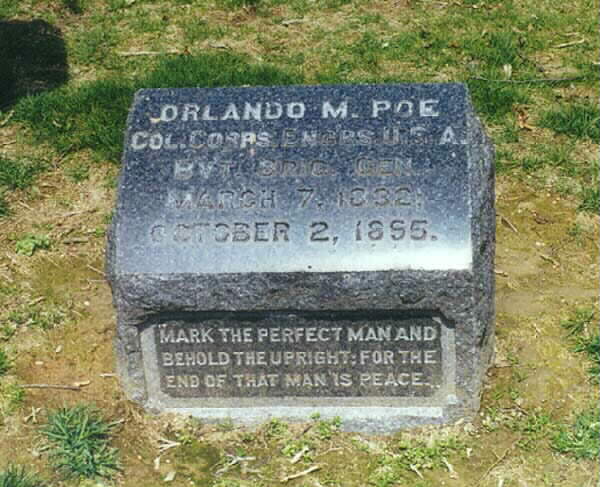
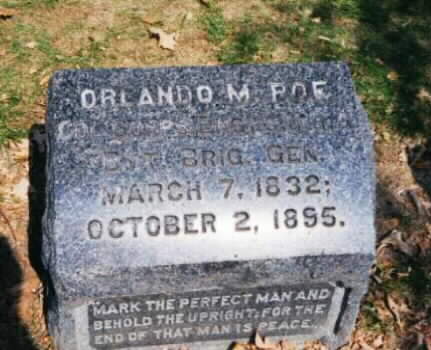
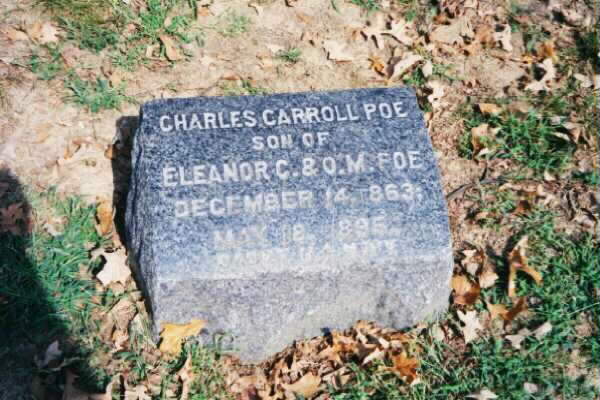
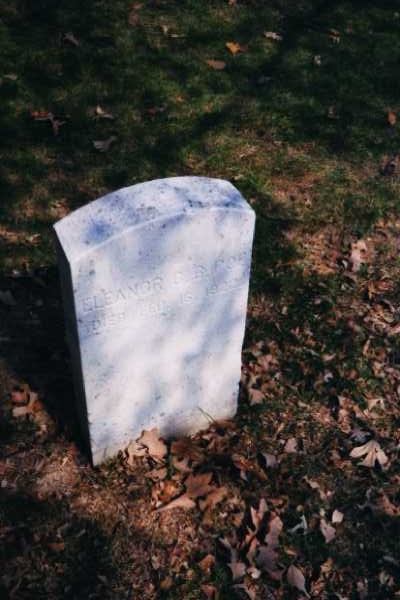
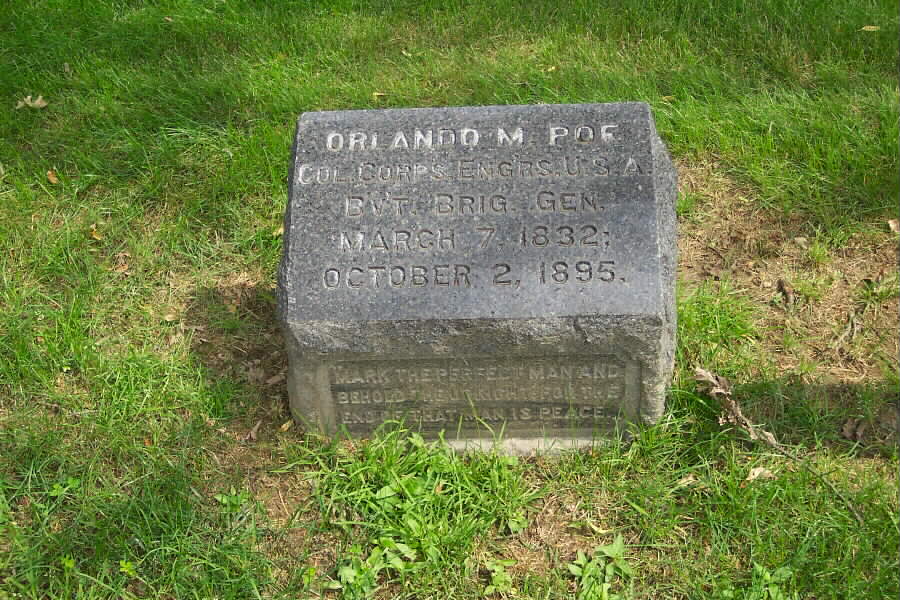
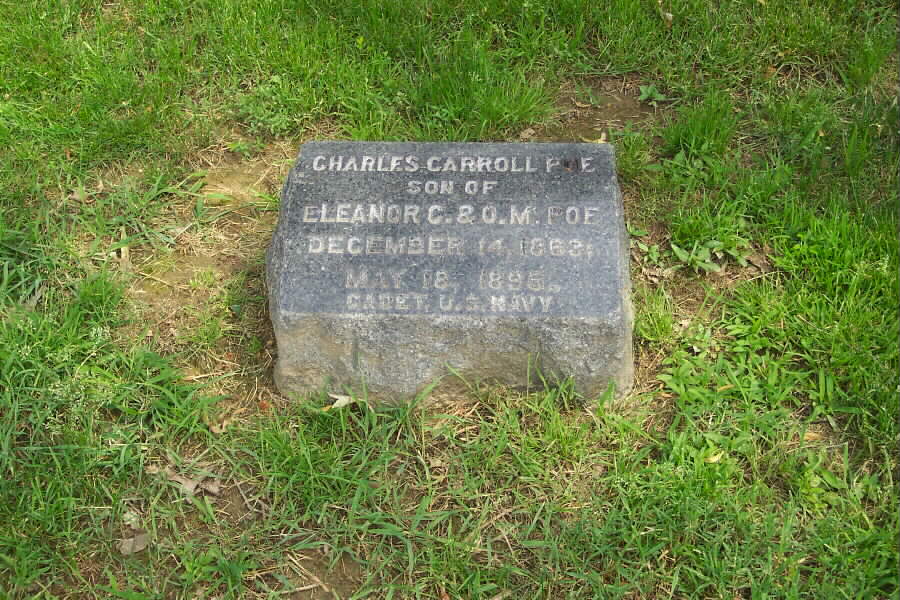
Michael Robert Patterson was born in Arlington and is the son of a former officer of the US Army. So it was no wonder that sooner or later his interests drew him to American history and especially to American military history. Many of his articles can be found on renowned portals like the New York Times, Washingtonpost or Wikipedia.
Reviewed by: Michael Howard

